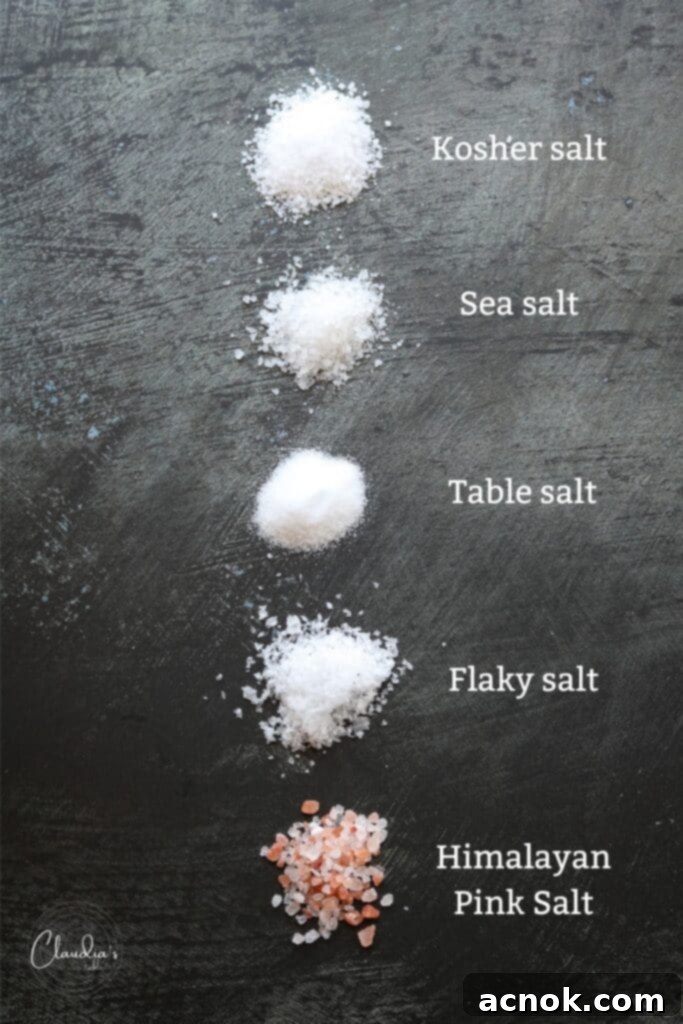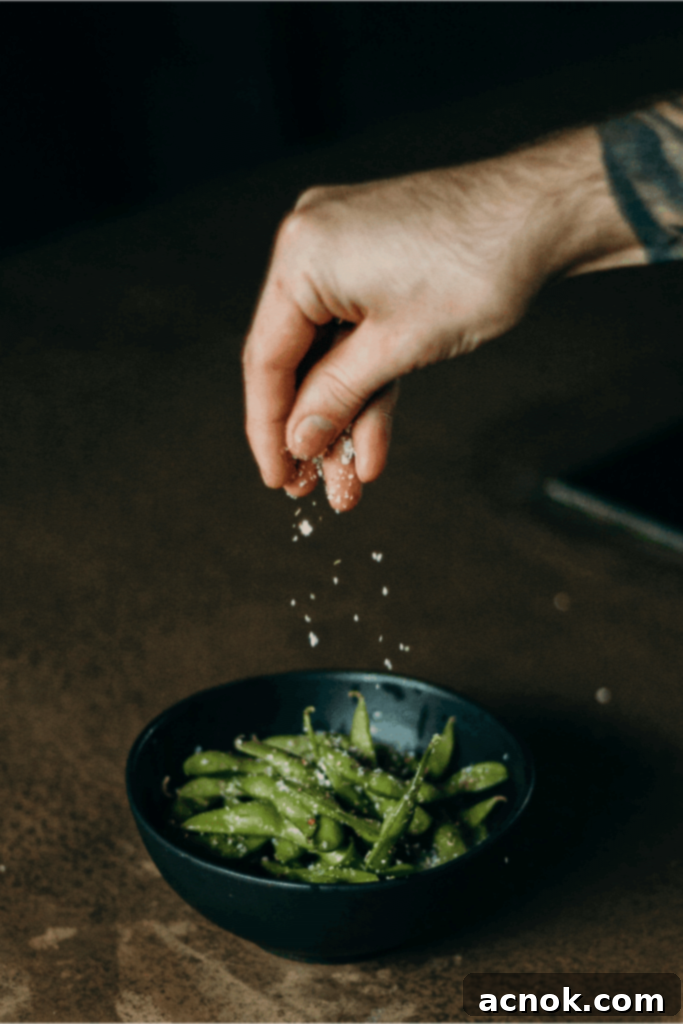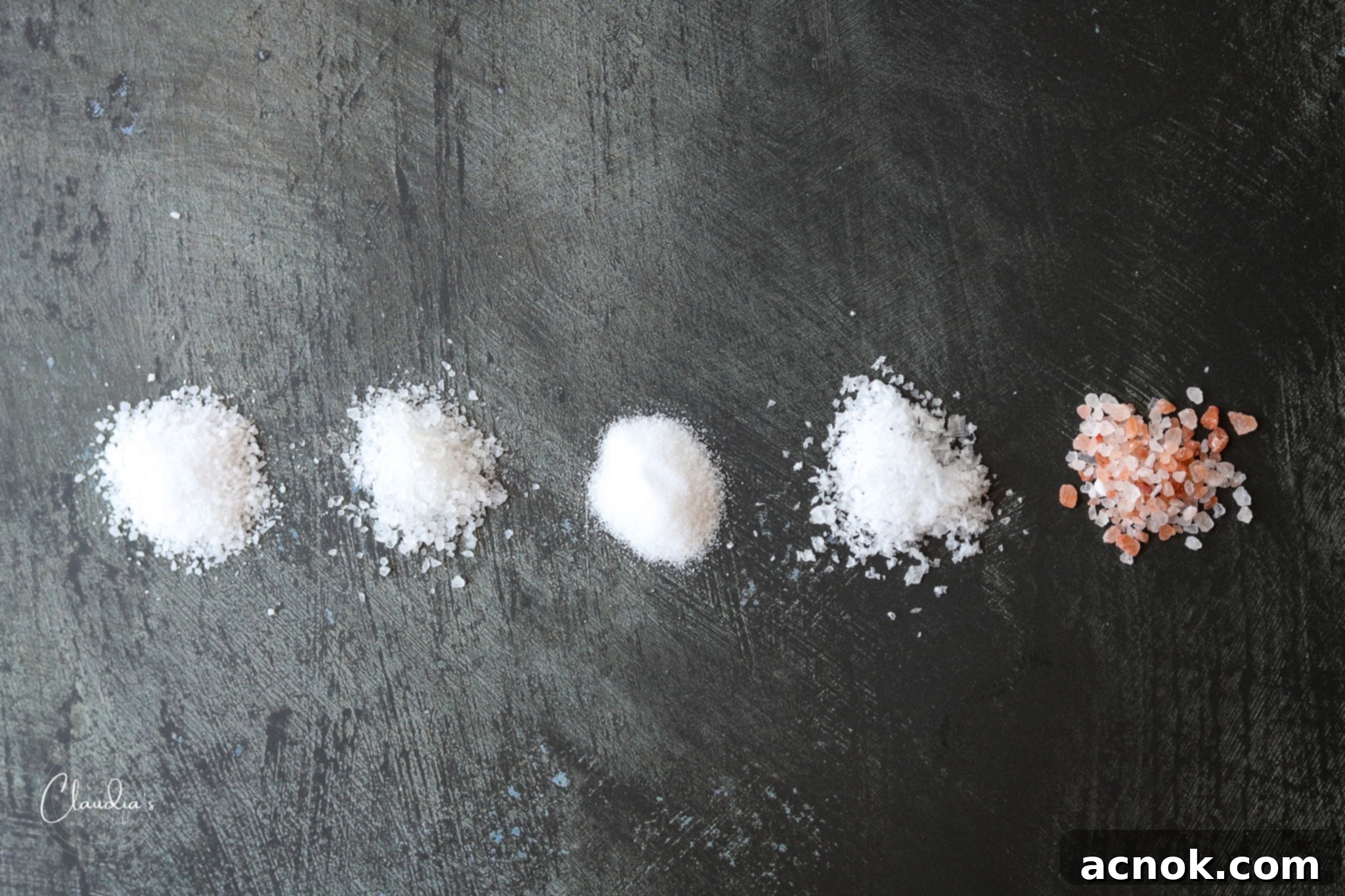Beyond the Shaker: A Home Cook’s Comprehensive Guide to Mastering Salt and Flavor
Salt. It’s an ingredient found in virtually every savory recipe, and often in sweet ones too, yet for many home cooks, it remains a culinary enigma. We know food needs it, but the questions often linger: When is the right time to add it? Is this enough? Have I gone too far? This comprehensive guide aims to demystify salt, offering a simple yet profound roadmap for every home cook. Here, you’ll discover the optimal types of salt for various applications, master the art of knowing when and how much to use, and learn how to sidestep common seasoning pitfalls. Understanding and effectively utilizing salt isn’t just a minor tweak; it’s a fundamental skill that will profoundly transform your daily cooking, elevating ordinary ingredients into extraordinary meals.

In my early culinary journey, when I first started taking cooking seriously, I, like many, believed there was essentially one kind of salt: the iodized table salt found in most pantries. Little did I know the vast and varied world of salts that awaited discovery. Today, a delightful array of salts from around the globe is readily accessible, offering diverse textures, mineral profiles, and flavors. This accessibility makes experimenting with different salts not just fun, but a genuinely rewarding experience that can dramatically enhance your dishes.
Why Salt Matters: The Unsung Hero of Flavor
Salt is far more than a mere seasoning agent; it is an indispensable flavor optimizer. In essence, salt makes food taste more intensely and authentically like itself. It doesn’t just add a salty taste; it unlocks and amplifies the intrinsic flavors of other ingredients, creating a more harmonious and complete taste experience. So, what exactly does this humble crystal accomplish in your cooking?
- Flavor Enhancement: Salt directly activates your taste buds, specifically enhancing our perception of umami and sweetness, while simultaneously suppressing bitterness. This intricate dance means a perfectly salted dish will taste more vibrant, complex, and utterly delicious.
- Balancing Act: Salt acts as a critical balancer of flavors. Consider a tart salad dressing or a sweet dessert; a pinch of salt can temper acidity and reduce cloying sweetness, bringing all the elements into perfect harmony. It’s the secret ingredient that makes disparate flavors sing together.
- Moisture Management: Salt is a natural dehydrator. It draws out moisture from ingredients, which is crucial for several cooking processes. This property helps tenderize proteins (think brining chicken) and contributes to achieving that coveted crispy texture on roasted vegetables or seared meats.
- Aiding the Maillard Reaction: Salt plays a role in facilitating the Maillard reaction, a complex chemical process responsible for the desirable browning and development of rich, savory flavors in foods. When searing meats or roasting vegetables, salt helps promote this reaction, leading to a beautifully caramelized crust and deeper flavor notes—much like the rich flavors of roasted coffee, perfectly charred meats, or golden-brown bread.
Have you ever cooked a recipe and felt that something indefinably “missing”? More often than not, the culprit is insufficient salt. Its ability to enhance the recipe as a whole is unparalleled. One of my culinary b bibles is Salt, Fat, Acid, Heat by Samin Nosrat. The very first foundational section of this incredible book is dedicated entirely to salt. I cannot recommend this book highly enough, whether you’re a kitchen novice or a seasoned cook. It serves as an invaluable reference, a practical guide, and a patient teacher, profoundly shaping how you approach cooking.

Types of Salt and When to Use Them: A Home Cook’s Primer
The vast world of salt reveals that not all varieties are created equal. Each possesses unique characteristics—from crystal size and texture to mineral content—that make it better suited for specific culinary tasks. Understanding these differences is key to becoming a more intuitive and skilled cook. Here’s an overview of the most commonly used salts in the home kitchen and their ideal applications:
- Kosher Salt: The All-Purpose Workhorse
- Kosher salt, distinguished by its coarse, flaky crystals, is widely regarded as the best all-purpose cooking salt by professional chefs and home cooks alike. Its larger grain size makes it easy to pinch and sprinkle, offering excellent control over seasoning. This translates to less chance of over-salting, as you can visibly see how much you’re adding.
- The two most popular Kosher salt brands in the U.S. are Diamond Crystal and Morton. While both are excellent, they differ significantly in volume due to their crystal structure. Morton Kosher salt is denser; therefore, roughly one teaspoon of Morton Kosher salt is equivalent to two teaspoons of Diamond Crystal Kosher salt by volume. For consistency in your recipes and to develop a reliable sense of seasoning, it’s highly recommended to stick to one brand. I personally use Morton brand Kosher salt due to its widespread availability and consistent results.
- Best Uses: Brining, seasoning meats and vegetables before and during cooking, boiling pasta water, making stocks and sauces. Its versatility makes it indispensable.
- Sea Salt: The Flavorful Finisher
- Harvested from evaporated seawater, sea salt often boasts larger, irregular crystals and a more complex, mineral-rich flavor profile compared to processed salts. Its distinct flavor can vary depending on its origin, retaining traces of naturally occurring minerals like calcium, potassium, and magnesium. Varieties like the delicate, flaky Maldon sea salt are particularly prized for their crunch and visual appeal.
- While sea salt can be used throughout the cooking process, its unique texture and nuanced flavor truly shine when used as a “finishing salt.” A sprinkle just before serving adds a delightful textural contrast and a burst of salty flavor that enhances the dish’s overall impact. For example, it perfectly complements my Simple Blood Orange Salad, providing a bright counterpoint. It’s also exceptional in baking, particularly in recipes like Chocolate Chip Cookies or chocolate candies, where it elevates sweetness and adds a pleasing crunch.
- Best Uses: Finishing dishes (salads, grilled meats, roasted vegetables), baking (especially with chocolate), seasoning seafood, and anywhere a pronounced texture and mineral flavor are desired.
- Table Salt: The Everyday Staple (with Caution)
- Table salt, typically mined from underground salt deposits, is highly refined and processed to remove impurities. It’s often fortified with iodine (an essential nutrient) and contains anti-caking agents to prevent clumping.
- Its super-fine, compact crystals make it incredibly dense and potent, meaning a small amount goes a long way. This density makes it less forgiving than Kosher salt, and it can be easy to over-salt if not used with extreme care. Because of its rapid dissolution and consistent sodium content, it is often recommended for precise measurements in baking recipes, where consistency is paramount.
- Best Uses: Precise measurements in baking, dissolving quickly in brines (though Kosher is preferred for taste). Use sparingly for general seasoning.
- Himalayan Pink Salt: The Visually Striking Mineral Powerhouse
- Mined from the Khewra Salt Mine in the Himalayan mountains of Pakistan, this salt is renowned for its beautiful pink hue, which comes from the trace minerals like iron oxide trapped within its crystals. Visually appealing, it can be found in various grinds, from fine to coarse.
- Himalayan pink salt boasts an impressive array of trace minerals, potentially offering a slightly different flavor profile than standard table or sea salt. It can be used interchangeably with sea salt or table salt, depending on the grind. Its aesthetic appeal also makes it popular for finishing dishes or as a decorative element.
- Best Uses: Everyday cooking (depending on grind), finishing dishes for visual appeal and a delicate mineral flavor, making decorative salt blocks for serving.
How Much Salt Should You Use? The Art of Progressive Seasoning
Determining the right amount of salt is perhaps the most nuanced aspect of seasoning, and it’s a skill that develops with practice, much like learning to master any new recipe. The key principle to embrace is “salt as you go,” gradually building layers of flavor rather than adding a large amount all at once.
Consider the classic example of salting water for cooking pasta. In my early days, I’d timidly add a small sprinkle of table salt. As I progressed and switched to Kosher salt, I became a bit more assertive. Now, I advocate for generously salting pasta water until it tastes “like the sea.” Why? Because pasta absorbs this seasoned water as it cooks, infusing the pasta itself with flavor, rather than relying solely on the sauce. A well-salted pasta is the foundation of a truly delicious pasta dish.
Another excellent illustration of progressive salting is in recipes cooked in stages, such as my mushroom fajitas. I begin by seasoning the mushrooms thoroughly with a spice rub that includes salt before they hit the pan. Once they’re beautifully browned and cooked, I remove them to make space for the peppers and onions. When these vegetables go into the skillet, often with a little more oil, I immediately add another pinch of Kosher salt. This seasons the vegetables as they cook, helping them caramelize and release their best flavors. Only after I combine the mushrooms back into the skillet do I taste the entire mixture and adjust the salt as needed. Furthermore, a component like my Chipotle Crema, which is served alongside, also contains salt in its own recipe. You can clearly see the principle at play here: each layer and component contributes its own element of salt, building a complex and balanced flavor profile. For this layered approach, I strongly recommend cooking with Kosher salt, as its larger crystals make it far more forgiving and easier to control than fine table salt. Furthermore, using the same brand of salt consistently will allow you to “learn” its potency and intuitively adjust quantities in all your recipes, becoming a more confident and skilled seasoner.
The Golden Rule of Thumb: Always salt as you go, incorporating small amounts at each stage of cooking to build and layer flavor onto the dish. Remember, you can always add more salt, but you can rarely take it away once added.
Navigating Pre-Seasoned Ingredients: When to Hold Back
While progressive salting is crucial, it’s equally important to be mindful of ingredients that already contain significant amounts of salt. Prepackaged items like chicken broth, vegetable stock, canned tomatoes, cured meats, and many cheeses can contribute a substantial amount of sodium to your dish. When using these, err on the side of caution: use less salt initially. You can always add more at the end after tasting.
My recipes are meticulously developed to account for the inherent salt content of prepared ingredients, and I consistently use Morton’s Kosher salt as my benchmark. For instance, in my Quick and Easy Weeknight Pasta Sauce, I often recommend using imported Italian tomatoes, which naturally have a lower sodium content than many American canned varieties. Similarly, any soup recipe incorporating chicken broth will require careful adjustment of additional salt during the final stages, as broth sodium levels can vary widely. Always check ingredient labels and opt for low-sodium versions of broths and canned goods when possible to give yourself more control over the final salt balance.
Quick Examples: Salting in Action
To solidify your understanding, here are some practical, everyday examples demonstrating effective salt application and the reasoning behind them:
- Pasta: Salt the water generously, until it tastes noticeably salty, like the ocean. This seasons the pasta from within, making it flavorful even without sauce.
- Vegetables (Roasting): Toss your vegetables with a good pinch of salt and olive oil before roasting. The salt draws out moisture, aiding in caramelization and creating beautiful browning and concentrated flavors.
- Beef (Steaks, Roasts): For best results, generously salt beef 30 minutes to an hour (or even overnight for thicker cuts) before cooking. This process, known as dry brining, not only deeply seasons the meat but also helps to tenderize it by breaking down muscle fibers and retaining moisture.
- Chicken (Whole or Parts): Salt chicken as much as a day in advance, storing it uncovered in the refrigerator. This dry brining technique leads to incredibly juicy meat and remarkably crispy skin, as the salt penetrates and draws moisture from the surface.
- Salad Greens: A small pinch of fine salt directly on your salad greens, along with a squeeze of lemon juice or vinegar, before dressing them can awaken their flavors and make them taste fresher. Many restaurants employ this trick.
- Eggs (Scrambled, Omelets): Always salt eggs before scrambling or cooking. Salt changes the protein structure, resulting in a creamier, more tender texture and significantly enhanced flavor.
- Soup: Add salt early in the recipe to season the foundation (aromatics, broth). Taste frequently as you add more ingredients and adjust at the very end. This builds a complex, well-rounded flavor.
- Breakfast Foods (Oatmeal, Grits): A small pinch of salt in oatmeal, grits, or cream of wheat is essential. It balances any sweetness, enhances the grain’s inherent flavor, and prevents the dish from tasting bland or flat.

Tried and True Tips for Salting Like a Pro
Beyond understanding the types and quantities, adopting a few simple habits will cement your mastery of salt in the kitchen:
- Use Your Fingers for Precision: Ditch the shaker for most tasks! Pinching salt between your fingers gives you far greater control over the amount and distribution, allowing for an even sprinkle and preventing accidental over-salting.
- Taste As You Go: This is arguably the most important tip. Seasoning is an iterative process. Taste your food at every major stage of cooking – after adding aromatics, after liquids, and just before serving. This allows you to adjust and build flavor thoughtfully.
- Make Salt Your BFF: Embrace salt as an indispensable partner in every dish. Think of it not just as an additive, but as the essential element that unlocks and elevates all other flavors. A well-seasoned dish is a delicious dish.
- Experiment with Finishing Salts: Explore the exciting world of finishing salts like flaky sea salts (Maldon), smoked salts, or specialty flavored salts. A sprinkle at the end adds a delightful textural crunch, a burst of concentrated flavor, and often a beautiful visual appeal that makes your dishes look and taste more professional.
Salting food effectively is a dynamic process, a true art that brings out the most delicious and nuanced flavors in your ingredients. It requires practice and an evolving palate, but once you master these fundamental principles, you will gain immense confidence in your recipes. You’ll move beyond guessing games, intuitively knowing how and when to season, and transform your everyday cooking into a more joyful and consistently delicious experience.
